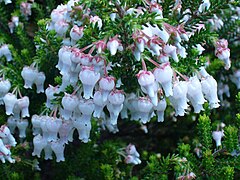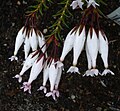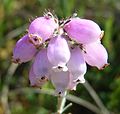Erica
| {{{name}}} LATINNAME
|
'
| ||||||||||||||||||||||||||||||||||||||||
|---|---|---|---|---|---|---|---|---|---|---|---|---|---|---|---|---|---|---|---|---|---|---|---|---|---|---|---|---|---|---|---|---|---|---|---|---|---|---|---|---|---|

|
|
| |||||||||||||||||||||||||||||||||||||||
| |||||||||||||||||||||||||||||||||||||||||
| Standard Cyclopedia of Horticulture |
|---|
|
Erica (practically meaningless; probably not from ereiko, to break, as commonly stated). Ericaceae. Heath. This is the genus that the gardener usually means by "heath." The heath or heather of English literature and history belongs to the closely allied genus Calluna. The next most important group of cultivated "heaths is Epacris, which, however, belongs to a different family. Ericas are perennial woody plants from 6 in. to 12 ft. or more, usually much branched: lvs. in whorls of 3-6. very rarely flat, usually 3-sided and with revolute margins that are sometimes connate with the under side: infl. usually terminal or sometimes axillary, very seldom actually, though often apparently, racemose; calyx free, 4- parted; corolla hypogynous, white, rosy or sometimes yellow, usually early deciduous, variously shaped, the commonest forms (in cult.) being bell- shaped, tubular and ventricose, usually 4-lobed; stamens 8; ovary sessile or rarely stalked, 4-celled, rarely 8-celled, with 2-∞ ovules in each cell: fr. a 4-valved caps., with minute seeds.— About 500 species, mostly from S. Afr. and the Medit. region, nine-tenths from the former. There are many hybrids and horticultural forms. So far as the S. African species are concerned, the latest monograph is that of Guthrie and Bolus, which has served as the basis for the treatment below. Only a few of the European heaths are hardy in America, and there are no native heaths at all in this hemisphere. Of about fourteen kinds of Erica grown outdoors in Europe to produce large showy masses, only three are hardy here, and it is safest to cover these with evergreen boughs in winter. Two others (E. mediterranea and E. lusitanica) are grown under glass somewhat but they are probably hardy, with protection, from New York southward. The tree heath of southern Europe (E. arborea) will probably never be a feature of our southern landscapes. The heath that is naturalized in places from Rhode Island to Newfoundland is Calluna vulgaris (which see); and this is sometimes advertised as Erica vulgaris. The halcyon days of the heaths were from about 1806 (when the English took the Cape of Good Hope) until the middle of the century. Andrews' colored engravings of heaths (1809) marks the first flush of their popularity. Practically, if not absolutely, all the heaths that are grown on a large scale have been developed from the South African species. The old English gardeners still lament the glorious days when the hard-wooded plants of Australia and the Cape formed the chief feature of European indoor horticulture. They complain that the present generation is not willing to give them the care they deserve. This is especially true of America. In America, heaths are of minor importance, even at Easter, and the kind grown most extensively for Christmas seems to be E. melanthera. The great trouble with heaths is the immense amount of care they need. Few, if any, classes of plants require more attention. Hence the growing of heaths for the market is extremely specialized, and there the American retail catalogues only rarely offer more than one species. Nevertheless, all the kinds described below are grown commercially, and are of the first importance in the genus. The stock is largely imported from England. Germany has a very different set of varieties, and France still another, and there are few cases among cultivated plants showing so great a difference in the three countries. The risks of importation are considerable, and the tendencies toward American independence in this line seem to be gaining. Another difficulty in heath-culture is the poor quality of peat obtainable in America. In England the peat is more fibrous, and has been formed in past ages largely by the decay of the native heather. The soft-wooded kinds are the ones most grown. The hard-wooded sorts require a longer period of growth and more thorough ripening of the wood. Apparently only one yellow-flowered heath is cultivated in America, E. Cavendishiana which is a hybrid species about which little is known. See supplementary list (p. 1132). In general, the ericas do not grow well in this climate on account of the extreme heat of the summer months, but some varieties grow and flower even better here than in Europe. The choice of the soil is very important. A light peat, mixed with sharp coarse sand is about the best we can get here. After flowering, the plants should always be cut down to keep them bushy at the base and well shaped. They will then receive a good repotting, always using very clean pots and plenty of drainage. Cuttings are made from December to April, preferably from young plants, the tender shoots about 1 inch in length being test. These are planted firmly in a pan filled with clean fine sand; and covered with a bell-glass, or in a box covered tightly with a pane of glass. Bottom heat is not necessary. When rooted, the cuttings should be potted in small pots, and when well started should be given as much air as possible. It is well to bring the ericas out of the greenhouse as early in the spring as possible. The pots should be plunged in a good location, where plenty of air and sunlight can be had. They should be wintered in a greenhouse extremely well ventilated, and a temperature not higher than 40° to 45° F. When in bud the plants should not be allowed to dry out too much. One drying might be enough to cause the loss of all the buds. Very often the heaths are attacked by a disease similar to mildew, brought on by an excess of humidity in the air. As this disease is very contagious, it is well, as soon as noticed, to use sulfur in powder or sulfate of copper in solution until the plants are rid of it. CH
|
Cultivation
- Do you have cultivation info on this plant? Edit this section!
Propagation
- Do you have propagation info on this plant? Edit this section!
Pests and diseases
- Do you have pest and disease info on this plant? Edit this section!
Species
Over 700 species, includingwp:
Erica arborea
Erica caffra
Erica carnea
Erica ciliaris
Erica cinerea
Erica erigena
Erica lusitanica
Erica mackaiana
Erica scoparia
Erica tetralix
Erica vagans
| Standard Cyclopedia of Horticulture |
|---|
|
The following are mostly kinds that have been grown successfully in small quantities in this country but appear not to be advertised in American trade catalogues. "H" equals hard-wooded; the rest are soft-wooded. 8. Afr., unless stated. Aside from these, E. scoparia, Linn., of S. Eu.. is sometimes listed: 2-3 ft., glabrous: lvs. in 3's: 3s. greenish, in 1-sided racemes: calyx-lobes about half the length of the subglobose corolla. E. capensis also appears, but it is apparently only a catalogue name. E. ampullacea, Curt. Lvs. ciliate, mucronate: bracts colored; fls. mostly in 4's; corolla ventricose, very stinky, typically white, lined with red; limb spreading, white. Var. rubra is the only form cult. B.M. 303. L.B.C. 6:508. H.— E. arborea var. alpina, W. I. Beau. An alpine variety, grown only at Kew. It is a stiff erect bush with tiny white fls. in plume-like clusters. Gn. 75, p. 384.—E. aristata, Andr. Readily distinguished by the long bristle which ends the lvs.: lvs. recurved: fls. in 4's; sepals keeled with red; corolla sticky, 1 in. long, ventricose, but with not so long and narrow a neck as in E. ampullacea. B.M. 1249. L.B.C. 1:73. H.—E. barbata, Andr. Bristly and glandular-pubescent: lvs. in 4's: corolla urn-shaped, villous; ovary villous. L.B.C. 2:124.—E. Bowieana, Lodd. Lvs. in 4's to 6's; infl. axillary; corolla tubular, lightly inflated; limb erect or scarcely open. L.B.C. 9:842.— E. Burnettii, Hort. Hybrid. F.S. 8:845.—E. Cavendishiana. Hort. (E. Cavendishii, Hort.). Hybrid of E. depressaxE. Patersonii. Lvs. in 4's, margins revolute: fls. in 2's to 4's; corolla tubular; stamens included; anthers awned. P.M. 13:3. G.C. 1845, p. 435; 11.18:213; 20:597. F.S. 2:142. A.F. 12:1143. Gng. 5:331. C.L.A. 7:180. G. 6:489; 10:243.— E. conspicua, Soland., is a species with club-shaped, villous fls. and villous lvs. in 4's. Var. splendens, Klotzsch, with the lvs. and sepals shining green and pubescent corollas, includes E. elata, Andr. L.B.C. 18:1788. — E. cylindrica, Andr. and Hort. Important hybrid of unknown parentage, cult. since 1800. Lvs. in 4's: fls. nearly sessile; corolla 1 in. long, brilliant rosy red, with a faint circle of dull blue about two- thirds of the way from the base; anthers awned, included; ovary glabrous. L.B.C. 18:1734. R.H. 1859, p. 42.—Fls. very showy and unusually long. The oldest E. cylindrica. That of Wendland is a yellow-fld, species unknown to cult.—E. Devoniana, Hort. Hybrid. Fls. rich purple. H. — E. elata, Andr.(syn. E. conspicua var. splendens). — E. Irbyana, Andr. Allied to E. ampullacea, but with corolla narrower at the base and tapering with perfect regularity to just below the limb, where it has a prominent red bulge. It is also distinctly lined with red, and the sepals are green, although the bracts are colored, as in E. ampullacea. L.B.C. 9:816. H. —E. nigrescens is presumably E. melanthera (H. D. Darlington). —E. pallida. A confused name. The oldest plant of this name is Salisbury's, which has an urn-shaped corolla, fls. often in 3's, pubescent and hirsute branches and lvs. in 3's. L.B.C. 1:72 (as E. pura). E. pallida of the trade is probably the tubular-fld. hybrid of Loddiges in L.B.C. 14:1355, which has axillary and terminal fls.. and lvs. in 4's to 6's.—E. persplcua, Wendl., has a tubular or slightly club-shaped corolla, lvs. in 4's, pubescent or rough-hairy, and fls. in 1's to 3's, but the plant in the trade is probably E. perspicuoides, Forbes, a hybrid, with longer and woollier hairs, fls. somewhat in umbels, nearly 1 in. long. Only var. erecta is grown here.—E. Syndriana is grown by Louis Dupuy.— E. translucent, Andr. Perhaps the first of all the garden hybrids between E. tubiflora and E ventricosa. Lvs. rigid, with or without long, soft, red hairs: fls. in umbel-like heads; bracts remote; corolla rosy, 8-9 lines long; tube narrowly ventricose, pubescent limb abort, spreading; ovary sessile. Andr. Heaths, 295. Bentham considers this a synonym of E. spuria, Andr. Heaths. 60. Schultheis says "it is the finest erica grown; a poor propagator but good grower. Takes 3 months to root."—E. tricolor is perhaps the most confused name in the genus, and apparently one of the important kinds abroad, where it has many varieties and synonyms. In the trade it seems to stand for a handsome heath, with lvs. in 4's, distinctly ciliate and terminated by a bristle: fls. in umbels of 8-10, 1 in. long, a little too inflated at the base for the typical tubular form, rosy at the base, then white, then green, and then suddenly constricted into a short neck; pedicels red and exceptionally long. This description is from L.B.C. 12:1105 (as E. eximia), one of the earliest pictures of these charming hybrids which Bentham refers to the hybrid E. aristella, Forbes.—E. Wilmorei, Knowles & Westc. (E. Wilmoreana and Vilmoreana, Hort.). Hybrid: corolla tubular, bulged below the lobes, slightly velvety-hairy: fls. in 1's to 3's, rosy, tipped white. R.H. 1892, p. 202. A.F. 4:251. G.C. III. 19:201. A.G. 21:869. Var. glauca, Carr., has nearly glaucous foliage. Var. calyculata, Carr., has a large additional calyx. R.H. 1892, p. 203. Wilhelm Miller. N. Taylor.
|
Gallery
If you have a photo of this plant, please upload it! Plus, there may be other photos available for you to add.
Erica baueri
ssp. baueriErica baueri
ssp. gouriquaeErica blenna
var. grandifloraErica vagans
pink
References
- Standard Cyclopedia of Horticulture, by L. H. Bailey, MacMillan Co., 1963






























































